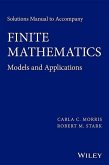Schade – dieser Artikel ist leider ausverkauft. Sobald wir wissen, ob und wann der Artikel wieder verfügbar ist, informieren wir Sie an dieser Stelle.
- Loseblattsammlung
Andere Kunden interessierten sich auch für
![Finite Mathematics Finite Mathematics]() Michael SullivanFinite Mathematics289,99 €
Michael SullivanFinite Mathematics289,99 €![Technology Resource Manual to Accompany Mathematics: An Applied Approach, 8e Technology Resource Manual to Accompany Mathematics: An Applied Approach, 8e]() Michael SullivanTechnology Resource Manual to Accompany Mathematics: An Applied Approach, 8e102,99 €
Michael SullivanTechnology Resource Manual to Accompany Mathematics: An Applied Approach, 8e102,99 €![Solutions Manual to Accompany Finite Mathematics Solutions Manual to Accompany Finite Mathematics]() Carla C MorrisSolutions Manual to Accompany Finite Mathematics34,99 €
Carla C MorrisSolutions Manual to Accompany Finite Mathematics34,99 €![Ordinary Differential Equations Ordinary Differential Equations]() Kenneth B. HowellOrdinary Differential Equations112,99 €
Kenneth B. HowellOrdinary Differential Equations112,99 €![Integration in Finite Terms Integration in Finite Terms]() Joseph Fels RittIntegration in Finite Terms44,00 €
Joseph Fels RittIntegration in Finite Terms44,00 €![Quantum finite automata with pairwise-commuting unitary operators Quantum finite automata with pairwise-commuting unitary operators]() Volodymyr G. SkobelevQuantum finite automata with pairwise-commuting unitary operators17,99 €
Volodymyr G. SkobelevQuantum finite automata with pairwise-commuting unitary operators17,99 €
Produktdetails
- Verlag: John Wiley & Sons
- 11th edition
- Erscheinungstermin: 29. März 2010
- Englisch
- Abmessung: 297mm x 297mm x 33mm
- Gewicht: 1633g
- ISBN-13: 9780470876671
- ISBN-10: 0470876670
- Artikelnr.: 33610897
- Herstellerkennzeichnung
- Libri GmbH
- Europaallee 1
- 36244 Bad Hersfeld
- gpsr@libri.de
Chapter 1: Linear Equations.
1.1. Lines.
1.2. Pairs of Lines.
1.3. Applications to Business and Economics.
1.4. Scatter Diagrams; Linear Curve Fitting.
Chapter Review.
Chapter Project.
Chapter 2: Systems of Linear Equations.
2.1 Systems of Linear Equations: Substitution; Elimination.
2.2 Systems of Linear Equations: Gauss-Jordan Method.
2.3 Systems of m Linear Equations Containing n Variables.
Chapter Review.
Chapter Project.
Chapter 3: Matrices.
3.1 Matrix Algebra.
3.2 Multiplication of Matrices.
3.3 The Inverse of a Matrix.
3.4 Applications in Economics (the Leontief Model), Accounting, and
Statistics (the Method of Least Squares).
Chapter Review.
Chapter Project.
Chapter 4: Linear Programming with Two Variables.
4.1 Systems of Linear Inequalities.
4.2 A Geometric Approach to Linear Programming Problems.
Chapter Review.
Chapter Project.
Chapter 5: Linear Programming: Simplex Method.
5.1 The Simplex Tableau; Pivoting.
5.2 The Simplex Method; Solving Maximum Problems in Standard Form.
5.3 Solving Minimum Problems Using the Daily Principle.
5.4 The Simplex Method for Problems Not in Standard Form.
Chapter Review.
Chapter Project.
Chapter 6: Finance.
6.1 Interest.
6.2 Compound Interest.
6.3 Annuities; Sinking Funds.
6.4 Present Value of an Annuity; Amortization.
6.5 Annuities and Amortization Using Recursive Sequences.
Chapter Review.
Chapter Project.
Chapter 7: Probability.
7.1 Sets.
7.2 The Number of Elements in a Set.
7.3 The Multiplication Principle.
7.4 Sample Spaces and the Assignment of Probabilities.
7.5 Properties of the Probability of an Event.
7.6 Expected Value.
Chapter Review.
Chapter Project.
Chapter 8: Bayes' Theorem; The Binomial Probability Model.
8.1 Conditional Probability.
8.2 Independent Events.
8.3 Bayes' Theorem.
8.4 Permutations.
8.5 Combinations.
8.6 The Binomial Probability Model.
Chapter Review.
Chapter Project.
Chapter 9: Statistics.
9.1 Introduction to Statistics: Data and Sampling.
9.2 Representing Qualitative Data Graphically: Bar Graphs; Pie Charts.
9.3 Organizing and Displaying Quantitative Data.
9.4 Measures of Central Tendency.
9.5 Measures of Dispersion.
9.6 The Normal Distribution.
Chapter Review.
Chapter Project.
Chapter 10: Markov Chains; Games.
10.1 Markov Chains and Transition Matrices.
10.2 Regular Markov Chains.
10.3 Absorbing Markov Chains.
10.4 Two-Person Games.
10.5 Mixed Strategies.
10.6 Optimal Strategy in Two-Person Zero-Sum Games with 2 X 2 Matrices.
Chapter Review.
Chapter Project.
Chapter 11: Logic.
11.1 Propositions.
11.2 Truth Tables.
11.3 Implications; The Biconditional Connective; Tautologies.
11.4 Arguments.
11.5 Logic Circuits.
Chapter Review.
Chapter Project.
Appendix A: Review.
A.1 Real Numbers.
A.2 Algebra Essentials.
A.3 Exponents and Logarithms.
A.4 Recursive Defined Sequences: Geometric Sequences.
Appendix B: Using LINDO to Solve Linear Programming Problems.
Appendix C: Graphing Utilities.
C.1 The Viewing Rectangle.
C.2 Using a Graphing Utility to Graph Equations.
C.3 Square Screens.
C.4 Using a Graphing Utility to Graph Inequalities.
Answers to Odd-Numbered Problems.
Photo Credits.
Index.
1.1. Lines.
1.2. Pairs of Lines.
1.3. Applications to Business and Economics.
1.4. Scatter Diagrams; Linear Curve Fitting.
Chapter Review.
Chapter Project.
Chapter 2: Systems of Linear Equations.
2.1 Systems of Linear Equations: Substitution; Elimination.
2.2 Systems of Linear Equations: Gauss-Jordan Method.
2.3 Systems of m Linear Equations Containing n Variables.
Chapter Review.
Chapter Project.
Chapter 3: Matrices.
3.1 Matrix Algebra.
3.2 Multiplication of Matrices.
3.3 The Inverse of a Matrix.
3.4 Applications in Economics (the Leontief Model), Accounting, and
Statistics (the Method of Least Squares).
Chapter Review.
Chapter Project.
Chapter 4: Linear Programming with Two Variables.
4.1 Systems of Linear Inequalities.
4.2 A Geometric Approach to Linear Programming Problems.
Chapter Review.
Chapter Project.
Chapter 5: Linear Programming: Simplex Method.
5.1 The Simplex Tableau; Pivoting.
5.2 The Simplex Method; Solving Maximum Problems in Standard Form.
5.3 Solving Minimum Problems Using the Daily Principle.
5.4 The Simplex Method for Problems Not in Standard Form.
Chapter Review.
Chapter Project.
Chapter 6: Finance.
6.1 Interest.
6.2 Compound Interest.
6.3 Annuities; Sinking Funds.
6.4 Present Value of an Annuity; Amortization.
6.5 Annuities and Amortization Using Recursive Sequences.
Chapter Review.
Chapter Project.
Chapter 7: Probability.
7.1 Sets.
7.2 The Number of Elements in a Set.
7.3 The Multiplication Principle.
7.4 Sample Spaces and the Assignment of Probabilities.
7.5 Properties of the Probability of an Event.
7.6 Expected Value.
Chapter Review.
Chapter Project.
Chapter 8: Bayes' Theorem; The Binomial Probability Model.
8.1 Conditional Probability.
8.2 Independent Events.
8.3 Bayes' Theorem.
8.4 Permutations.
8.5 Combinations.
8.6 The Binomial Probability Model.
Chapter Review.
Chapter Project.
Chapter 9: Statistics.
9.1 Introduction to Statistics: Data and Sampling.
9.2 Representing Qualitative Data Graphically: Bar Graphs; Pie Charts.
9.3 Organizing and Displaying Quantitative Data.
9.4 Measures of Central Tendency.
9.5 Measures of Dispersion.
9.6 The Normal Distribution.
Chapter Review.
Chapter Project.
Chapter 10: Markov Chains; Games.
10.1 Markov Chains and Transition Matrices.
10.2 Regular Markov Chains.
10.3 Absorbing Markov Chains.
10.4 Two-Person Games.
10.5 Mixed Strategies.
10.6 Optimal Strategy in Two-Person Zero-Sum Games with 2 X 2 Matrices.
Chapter Review.
Chapter Project.
Chapter 11: Logic.
11.1 Propositions.
11.2 Truth Tables.
11.3 Implications; The Biconditional Connective; Tautologies.
11.4 Arguments.
11.5 Logic Circuits.
Chapter Review.
Chapter Project.
Appendix A: Review.
A.1 Real Numbers.
A.2 Algebra Essentials.
A.3 Exponents and Logarithms.
A.4 Recursive Defined Sequences: Geometric Sequences.
Appendix B: Using LINDO to Solve Linear Programming Problems.
Appendix C: Graphing Utilities.
C.1 The Viewing Rectangle.
C.2 Using a Graphing Utility to Graph Equations.
C.3 Square Screens.
C.4 Using a Graphing Utility to Graph Inequalities.
Answers to Odd-Numbered Problems.
Photo Credits.
Index.
Chapter 1: Linear Equations.
1.1. Lines.
1.2. Pairs of Lines.
1.3. Applications to Business and Economics.
1.4. Scatter Diagrams; Linear Curve Fitting.
Chapter Review.
Chapter Project.
Chapter 2: Systems of Linear Equations.
2.1 Systems of Linear Equations: Substitution; Elimination.
2.2 Systems of Linear Equations: Gauss-Jordan Method.
2.3 Systems of m Linear Equations Containing n Variables.
Chapter Review.
Chapter Project.
Chapter 3: Matrices.
3.1 Matrix Algebra.
3.2 Multiplication of Matrices.
3.3 The Inverse of a Matrix.
3.4 Applications in Economics (the Leontief Model), Accounting, and
Statistics (the Method of Least Squares).
Chapter Review.
Chapter Project.
Chapter 4: Linear Programming with Two Variables.
4.1 Systems of Linear Inequalities.
4.2 A Geometric Approach to Linear Programming Problems.
Chapter Review.
Chapter Project.
Chapter 5: Linear Programming: Simplex Method.
5.1 The Simplex Tableau; Pivoting.
5.2 The Simplex Method; Solving Maximum Problems in Standard Form.
5.3 Solving Minimum Problems Using the Daily Principle.
5.4 The Simplex Method for Problems Not in Standard Form.
Chapter Review.
Chapter Project.
Chapter 6: Finance.
6.1 Interest.
6.2 Compound Interest.
6.3 Annuities; Sinking Funds.
6.4 Present Value of an Annuity; Amortization.
6.5 Annuities and Amortization Using Recursive Sequences.
Chapter Review.
Chapter Project.
Chapter 7: Probability.
7.1 Sets.
7.2 The Number of Elements in a Set.
7.3 The Multiplication Principle.
7.4 Sample Spaces and the Assignment of Probabilities.
7.5 Properties of the Probability of an Event.
7.6 Expected Value.
Chapter Review.
Chapter Project.
Chapter 8: Bayes' Theorem; The Binomial Probability Model.
8.1 Conditional Probability.
8.2 Independent Events.
8.3 Bayes' Theorem.
8.4 Permutations.
8.5 Combinations.
8.6 The Binomial Probability Model.
Chapter Review.
Chapter Project.
Chapter 9: Statistics.
9.1 Introduction to Statistics: Data and Sampling.
9.2 Representing Qualitative Data Graphically: Bar Graphs; Pie Charts.
9.3 Organizing and Displaying Quantitative Data.
9.4 Measures of Central Tendency.
9.5 Measures of Dispersion.
9.6 The Normal Distribution.
Chapter Review.
Chapter Project.
Chapter 10: Markov Chains; Games.
10.1 Markov Chains and Transition Matrices.
10.2 Regular Markov Chains.
10.3 Absorbing Markov Chains.
10.4 Two-Person Games.
10.5 Mixed Strategies.
10.6 Optimal Strategy in Two-Person Zero-Sum Games with 2 X 2 Matrices.
Chapter Review.
Chapter Project.
Chapter 11: Logic.
11.1 Propositions.
11.2 Truth Tables.
11.3 Implications; The Biconditional Connective; Tautologies.
11.4 Arguments.
11.5 Logic Circuits.
Chapter Review.
Chapter Project.
Appendix A: Review.
A.1 Real Numbers.
A.2 Algebra Essentials.
A.3 Exponents and Logarithms.
A.4 Recursive Defined Sequences: Geometric Sequences.
Appendix B: Using LINDO to Solve Linear Programming Problems.
Appendix C: Graphing Utilities.
C.1 The Viewing Rectangle.
C.2 Using a Graphing Utility to Graph Equations.
C.3 Square Screens.
C.4 Using a Graphing Utility to Graph Inequalities.
Answers to Odd-Numbered Problems.
Photo Credits.
Index.
1.1. Lines.
1.2. Pairs of Lines.
1.3. Applications to Business and Economics.
1.4. Scatter Diagrams; Linear Curve Fitting.
Chapter Review.
Chapter Project.
Chapter 2: Systems of Linear Equations.
2.1 Systems of Linear Equations: Substitution; Elimination.
2.2 Systems of Linear Equations: Gauss-Jordan Method.
2.3 Systems of m Linear Equations Containing n Variables.
Chapter Review.
Chapter Project.
Chapter 3: Matrices.
3.1 Matrix Algebra.
3.2 Multiplication of Matrices.
3.3 The Inverse of a Matrix.
3.4 Applications in Economics (the Leontief Model), Accounting, and
Statistics (the Method of Least Squares).
Chapter Review.
Chapter Project.
Chapter 4: Linear Programming with Two Variables.
4.1 Systems of Linear Inequalities.
4.2 A Geometric Approach to Linear Programming Problems.
Chapter Review.
Chapter Project.
Chapter 5: Linear Programming: Simplex Method.
5.1 The Simplex Tableau; Pivoting.
5.2 The Simplex Method; Solving Maximum Problems in Standard Form.
5.3 Solving Minimum Problems Using the Daily Principle.
5.4 The Simplex Method for Problems Not in Standard Form.
Chapter Review.
Chapter Project.
Chapter 6: Finance.
6.1 Interest.
6.2 Compound Interest.
6.3 Annuities; Sinking Funds.
6.4 Present Value of an Annuity; Amortization.
6.5 Annuities and Amortization Using Recursive Sequences.
Chapter Review.
Chapter Project.
Chapter 7: Probability.
7.1 Sets.
7.2 The Number of Elements in a Set.
7.3 The Multiplication Principle.
7.4 Sample Spaces and the Assignment of Probabilities.
7.5 Properties of the Probability of an Event.
7.6 Expected Value.
Chapter Review.
Chapter Project.
Chapter 8: Bayes' Theorem; The Binomial Probability Model.
8.1 Conditional Probability.
8.2 Independent Events.
8.3 Bayes' Theorem.
8.4 Permutations.
8.5 Combinations.
8.6 The Binomial Probability Model.
Chapter Review.
Chapter Project.
Chapter 9: Statistics.
9.1 Introduction to Statistics: Data and Sampling.
9.2 Representing Qualitative Data Graphically: Bar Graphs; Pie Charts.
9.3 Organizing and Displaying Quantitative Data.
9.4 Measures of Central Tendency.
9.5 Measures of Dispersion.
9.6 The Normal Distribution.
Chapter Review.
Chapter Project.
Chapter 10: Markov Chains; Games.
10.1 Markov Chains and Transition Matrices.
10.2 Regular Markov Chains.
10.3 Absorbing Markov Chains.
10.4 Two-Person Games.
10.5 Mixed Strategies.
10.6 Optimal Strategy in Two-Person Zero-Sum Games with 2 X 2 Matrices.
Chapter Review.
Chapter Project.
Chapter 11: Logic.
11.1 Propositions.
11.2 Truth Tables.
11.3 Implications; The Biconditional Connective; Tautologies.
11.4 Arguments.
11.5 Logic Circuits.
Chapter Review.
Chapter Project.
Appendix A: Review.
A.1 Real Numbers.
A.2 Algebra Essentials.
A.3 Exponents and Logarithms.
A.4 Recursive Defined Sequences: Geometric Sequences.
Appendix B: Using LINDO to Solve Linear Programming Problems.
Appendix C: Graphing Utilities.
C.1 The Viewing Rectangle.
C.2 Using a Graphing Utility to Graph Equations.
C.3 Square Screens.
C.4 Using a Graphing Utility to Graph Inequalities.
Answers to Odd-Numbered Problems.
Photo Credits.
Index.







